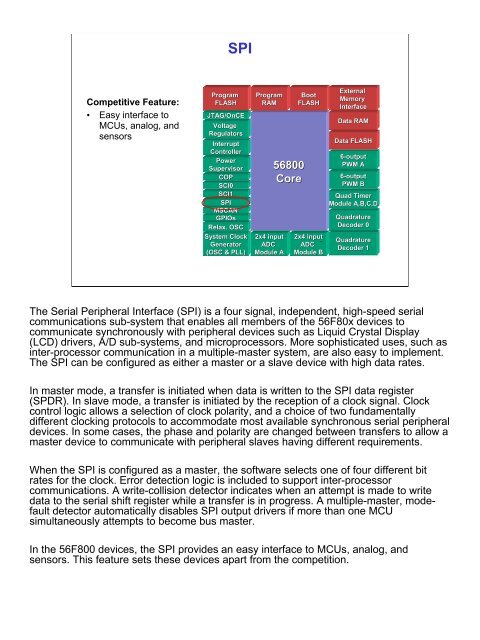Open PDF
Open PDF
Open PDF
You also want an ePaper? Increase the reach of your titles
YUMPU automatically turns print PDFs into web optimized ePapers that Google loves.
SPI<br />
Competitive Feature:<br />
• Easy interface to<br />
MCUs, analog, and<br />
sensors<br />
Program<br />
FLASH<br />
JTAG/OnCE<br />
Voltage<br />
Regulators<br />
Interrupt<br />
Controller<br />
Power<br />
Supervisor<br />
COP<br />
SCI0<br />
SCI1<br />
SPI<br />
MSCAN<br />
GPIOs<br />
Relax. OSC<br />
System Clock<br />
Generator<br />
(OSC & PLL)<br />
Program<br />
Boot<br />
RAM<br />
FLASH<br />
56800<br />
Core<br />
2x4 input<br />
2x4 input<br />
ADC<br />
ADC<br />
Module A<br />
Module B<br />
External<br />
Memory<br />
Interface<br />
Data RAM<br />
Data FLASH<br />
6-output<br />
PWM A<br />
6-output<br />
PWM B<br />
Quad Timer<br />
Module A,B,C,D<br />
Quadrature<br />
Decoder 0<br />
Quadrature<br />
Decoder 1<br />
The Serial Peripheral Interface (SPI) is a four signal, independent, high-speed serial<br />
communications sub-system that enables all members of the 56F80x devices to<br />
communicate synchronously with peripheral devices such as Liquid Crystal Display<br />
(LCD) drivers, A/D sub-systems, and microprocessors. More sophisticated uses, such as<br />
inter-processor communication in a multiple-master system, are also easy to implement.<br />
The SPI can be configured as either a master or a slave device with high data rates.<br />
In master mode, a transfer is initiated when data is written to the SPI data register<br />
(SPDR). In slave mode, a transfer is initiated by the reception of a clock signal. Clock<br />
control logic allows a selection of clock polarity, and a choice of two fundamentally<br />
different clocking protocols to accommodate most available synchronous serial peripheral<br />
devices. In some cases, the phase and polarity are changed between transfers to allow a<br />
master device to communicate with peripheral slaves having different requirements.<br />
When the SPI is configured as a master, the software selects one of four different bit<br />
rates for the clock. Error detection logic is included to support inter-processor<br />
communications. A write-collision detector indicates when an attempt is made to write<br />
data to the serial shift register while a transfer is in progress. A multiple-master, modefault<br />
detector automatically disables SPI output drivers if more than one MCU<br />
simultaneously attempts to become bus master.<br />
In the 56F800 devices, the SPI provides an easy interface to MCUs, analog, and<br />
sensors. This feature sets these devices apart from the competition.













